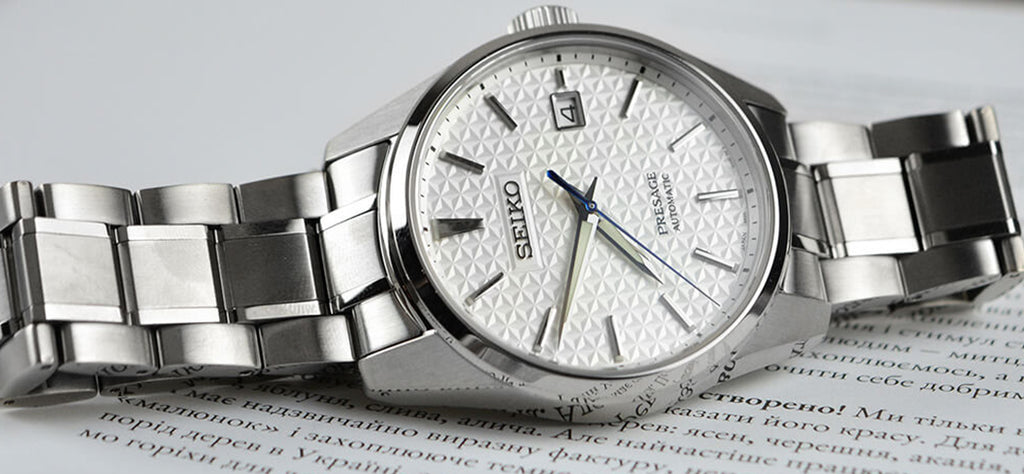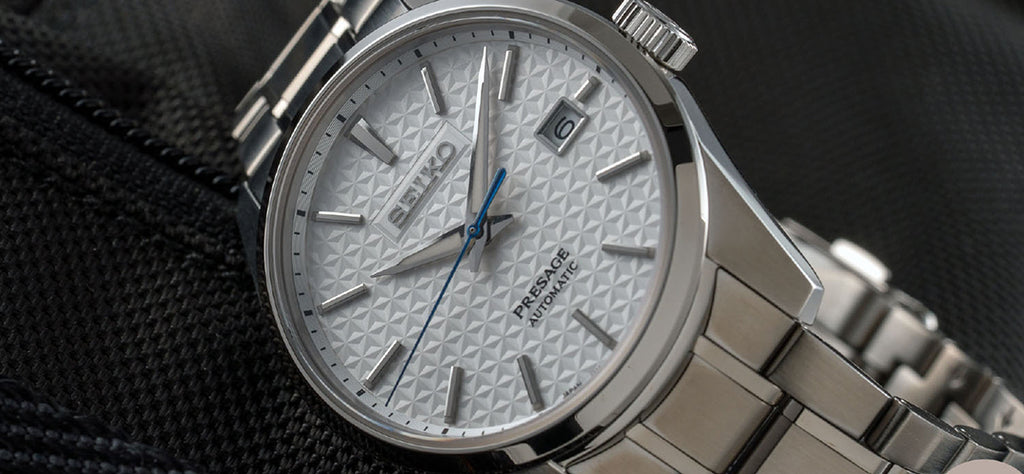A Quick Recap...

It would be the understatement of the century to say that the Swiss and Japanese watch industry have had a bit of a bitter rivalry with each other for decades. For those who missed part 1 of our East vs West blogpost, here’s the crux of it. Back in 1927, it was discovered that if you run an electrical current through a quartz crystal, the piezoelectrical properties of the crystal would cause it to beat at a highly precise frequency, allowing it to regulate an electronic oscillator that can in turn, regulate time. And even more accurately so than mechanical watches. It was this piece of technology that allowed Seiko to beat the Swiss during the Swiss accuracy trials in 1969 and ultimately leading to the destruction of traditional mechanical watchmaking in the 1970s with quartz being the future.

It’s safe to say that the quartz crisis triggered by Seiko’s Astron in 1969 nearly wiped-out mechanical watches along with many Swiss watch brands that we know and love today as well as many others who were unfortunately relegated into the annals of history, never to be seen or heard from again. The reason why former Swiss powerhouses like Omega, Zenith and IWC, now trail behind the young upstart Rolex. Why a once great movement manufacturer like Minerva, is now a mere shadow of its former self, making movements for Montblanc watches under Richemont. Is because of the quartz crisis triggered by Seiko.
The Saving Grace Of Mechanical Watchmaking

Fortunately, the art and practice of traditional mechanical watchmaking survived this massacre. Thanks largely to the birth of the iconic Audemars Piguet Royal Oak designed by one Gerald Genta. It was an angular, industrially designed stainless-steel sports watch with an integrated bracelet that at the time (and even now) costs more than a solid gold watch. What Genta did with the Royal Oak was turn the mechanical wristwatch into a luxury, a status symbol. And that, along with a few other bold releases sharing similar design styles such as the Patek Philippe Nautilus and the Vacheron Constantin 222 (Now known as the Overseas) were the saving grace of traditional mechanical watchmaking.
More Than Just A Pulse

Now, with the arrival of young powerhouses like Hublot, Roger Dubuis and Armin Strom, to funky and left field horological marvels like MB&F and Debethune. Are living proof that the art of traditional mechanical watchmaking and haute horology is still going strong.

Needless to say, the Swiss watch industry still has a bit of a chip on its shoulder from this near-death-experience triggered by the Japanese, and the rivalry between these two horological giants still rage on till this day. Right off the bat, we’re not here to say who is superior to the other, both of them are equally respectable and coveted in their field of watchmaking, but they both have their own unique way of getting things done. With watches like the Seiko Credor Eichi II, a time only quartz three hander (granted one that was created and developed by a studio established by Philippe Dufour himself) knocking on the door of $100,000; that’s dangerously close to Patek Philippe Annual Calendar money now. Being sold out everywhere; you’ll be lucky to even get one in your local A.D.

There is certainly still a strong demand for high-end Japanese timepieces, even in the presence of the more mainstream Swiss and even German powerhouses like Vacheron Constantin and A Lange & Söhne. Though watches like these are reserved for those who can afford to play the game, that doesn’t mean that you can’t get a slice of this beautiful heritage without having to sell your children.
A Slice Of A Beautiful Heritage For A Reasonable Price

Enter brands like Seiko, and Tissot, these manufacturers offer you a piece of that colourful history for a fraction of the price of the aforementioned Credor. And while similarly priced they are, similar they are not, one coming from Switzerland and another hailing from Japan. Choosing the right watch for you might no longer just be a question of which one is better than the other, rather which one of these (and by that, I mean in the way that they are built, the values and the focuses of each of them as well) relates more to you, your preference and values. To help make that decision less headache inducing, we’ve laid out 2 daily stainless-steel dress watches, the Seiko Presage Sharp-Edged SPB165J1, and the Tissot Gentleman T127407110601. Why stainless-steel dressy sports watches? Well, it’s simple; they’re immensely popular and timeless in design and it’s the possibly the most versatile design for a modern watch these days (thanks largely to the Rolex Datejust) and also because, well they’re damn good watches and we all love a daily dress watch.
SEIKO PRESAGE SPB165J1 SHARP EDGE MEN'S WATCH
While all the offerings that we’ve seen from the Seiko Presage line have been subtle, classic dress watches (albeit some with a bit of a flamboyant flair), we haven’t really touched on something a bit more casual, and perhaps more suited for daily wear. Enter the SPB165J1, Seiko’s answer to our calls for a classic Japanese made stainless-steel dressy sports watch.
Now, Seiko does make proper dress watches, their Cocktail time and the rest of the Presage range can attest to that. But this SPB165J1 is a very different type of sports watch, coming in a relatively slim polished and brushed angular, stainless steel case. 39mm in diameter and with an integrated bracelet design, it’s a modern approach on a stainless-steel sports watch but with a Seiko twist. If you couldn’t already tell by the name, the watch’s case and bracelet incorporates many flat surfaces with modern sharpness that allows the watch to catch and reflect light at many different angles.

The dial is stunning too, in a stark snowy white with Seiko’s own Asanoha (Hemp leaf) pattern. Seiko has come a long way from making stunning dials, from their entry level cocktail time, to their immaculately stunning and expensive Grand Seiko Snowflake. I believe that the Presage sharp edge, with its gorgeous Asanoha patterned dial, robust yet elegantly finished case is the perfect middle ground between the entry level Presage timepieces and the properly high-end Grand Seiko timepieces. Hell, I think this could even be a proper new ‘Baby Snowflake’ for us common folk too.

The SPB165J1 is powered by Seiko’s own 6r35 automatic movement, offering 70 hours of power-reserve, hacking and hand-winding. Its neatly finished as you’d expect and for a watch that costs as much as this does, and it really doesn’t get any better than that.
What we’ve ended up with in the SPB165J1 is a stunning daily wearer with classic Japanese design proportions and practicality, with an immensely beautiful and idiosyncratically Japanese artsy dial design. And if that doesn’t make you want one already, you’re quite possibly in the wrong hobby.
TISSOT POWERMATIC 80 SILICIUM T1274071104100 MEN'S WATCH

It may not look like it, but the Tissot Gentleman Powermatic 80 is a fantastic stainless-steel every-day dress watch. It’s a timeless design that works no matter the occasion, whether you’re in jeans or shorts for a weekend out or in a suit for a gala dinner, this simple steel sports watch will never look out of place.
The watch that exemplifies this design best is, of course, the Rolex Datejust. But what if we don’t want to spend upwards of $10,000 on a stainless-steel Swiss made sports watch, but still want something special with similar aesthetics without having to break the bank? Well, Tissot has heard your calls and have responded with this: the Powermatic 80 Silicium T1274071104100. It’s part of Tissot’s Gentleman line, so we’ll just call it that for short.

The design is a simple formula that’s worked for over half a century and still will for the next. With a smooth stainless-steel bezel surrounding a satin-finished sunburst blue dial adorned with sharp, applied indexes and hands.
It’s a handsome watch and fits the bill of a gentleman’s timepiece perfectly. Elegant, ergonomic, refined yet strong enough to get a little rough. The 100m of water-resistant is a nice touch too, giving the watch the robustness that it needs for everyday use. Though it is really the movement of this watch that’s what makes it unique. It’s Tissot’s own Powermatic 80 caliber that offers a hefty 80 hours of power reserve and paired with a Silicon escapement which makes the watch even more magnetism-resistant than before.

It’s an interesting piece of technological innovation that is rarely ever seen in watches of this price range, and when you put it next to the Rolex with its own Silicium escapement as well, getting that same bit of technology and refined design in a watch a tenth of the price makes the Gentleman look like the bargain of the century.
Stunning and timeless dress watches

You may have noticed, that both of these watches, although rather similar on paper: Stainless-steel dress watches, automatics with about 3 days of power reserve and displaying only the time and date. But they are in fact, vastly different. The Seiko may be the more refined of the pair (ironically) thanks to its stunning dial, multi-faceted markers and angular case and bracelet too. It is still a proper modern daily dress watch that you can reliably count on. The Tissot is easily capable of the performance that the Seiko offers and yet they both offer something a bit more than just being simple daily dress watches. What they offer is an almost artistic and intriguing insight into what traditional mechanical Swiss watchmaking was and is today. These watches can trade blows all day long, the Seiko being the only one powered by an actual in-house made caliber, but with 10 hours less power reserve compared to the Tissot. While the Tissot, has a timeless and contemporary aesthetic, the Seiko, in my eye at least looks all the better with its sharp case and patterned dial. So, what does this mean then? Do we simply go for the Seiko because its in-house movement and beautifully finished dial puts it at an inherent advantage over the Tissot? No, it’s much more than that. And to be able to have these watches and have a dilemma like this is truly a moment to savour after all, if we all bought watches with our heads, we wouldn’t even have mechanical watches at all in this day and age, and who would want to live in a world like that?


